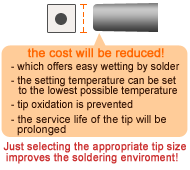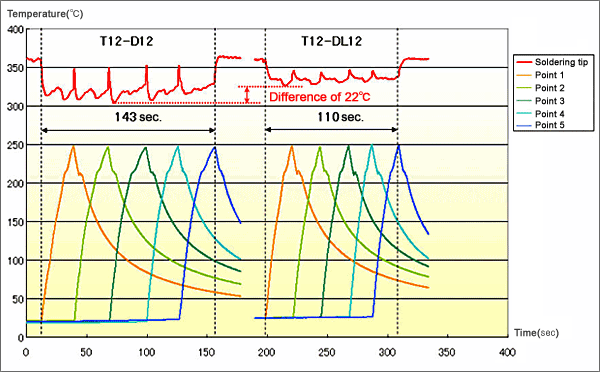
Select tip shape
HAKKO Recommendations for Selection of Tip Size (Diameter)
When selecting the most suitable tip size (diameter) for the workpiece, what do you base your selection on? When soldering, if the tip shape has already been determined, then you may be at a loss to select the size (diameter). How do you select what size (diameter) to use?
If the proper size (diameter) for the workpiece is selected, the following merits will be obtained and the “soldering environment” will be improved.

- Heat will be efficiently transferred to the workpiece, which offers easy wetting by solder.
- If wetting by solder is easy, the setting temperature can be set to the lowest possible temperature.
- If the set temperature is lower, tip oxidation is prevented.
- If tip oxidation is prevented, the service life of the tip will be prolonged.
- If the service life of the tip is prolonged, the cost will be reduced!
Now, let’s study how to select a tip with the appropriate size by using the T12 series Shape D as an example.
Step 2 Select a tip with as high a heat storage capacity as possible.
For example, which of the following tips do you choose? The end of both tips is 1.2mm, which is just appropriate for the workpiece.


Although the tip size is the same for both, the heat storage capacity is different.
The tip size of T12-D12 and T12-DL12 is 1.2mm; however, DL12 looks larger overall. This produces differences in the heat storage capacity, which contributes to improving the soldering environment.
Therefore, select a tip with the highest heat storage capacity possible if the size is the same. Further, reduce the size gradually considering various conditions such as narrow pitch, etc.
The difference in storage heat amount can be confirmed by the difference in temperature drop (refer to the temperature comparison graph). If the temperature drop is small, the set temperature can be kept lower. It is unnecessary to set the temperature excessively high. The working time required for one soldering operation can be reduced, resulting in a reduction of working time for the day.
(T12 series has Heavy Duty Type. This type enables soldering at narrow pitches in which the tip end of L type touches the near by ICs.)

Temperature comparison graph between T12-D12 and T12-DL12
Measurement conditions
| Measurement method | Measure the time until temperature of workpiece is increased up to 250ºC when 5-point soldering is performed. |
| Board | Bakelite board |
| Component | Terminal (External diameter Φ8.5 / Internal diameter Φ4) |
| Tip shape | T12-D12 and T12-DL12 |
| Temperature setting | 360ºC |
| Solder | Lead-free solder (Sn-3Ag-0.5Cu) Φ0.5 |

Only T12 series offers Heavy Duty Type which has larger heat capacity than Standard type (T12-D12).
Temperature comparison graph between T12-D12, Heavy Duty Type (T12- WD-12) and T12-DL12
Comment
The difference in heat storage capacity produced a difference in temperature drop of 22ºC. If the drop in temperature is small even for the same set temperature (refer to the set temperature of the test conditions), working time can be reduced (143 sec – 110 sec = 33 sec).
Thus, reduction in the soldering time prevents the tip from being oxidized. In addition to selection of products compatible with lead-free soldering, we strongly recommend selecting the appropriate tip size. It will improve your soldering environment.





